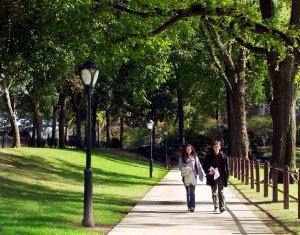February 20, 2018

Adolescents living in areas surrounded by trees and other green vegetation have better mental health than those exposed to less greenery at home, according to new research supported in part by the Environmental Health Sciences Core Center at Harvard University. The study is one of the first to examine the relationship between natural environments and depressive symptoms in adolescents.
According to the authors, prior research has shown that less exposure to nature is associated with poorer mental health outcomes, but this research has focused primarily on adults.
To examine how exposure to nature affects teens’ mental health, the research team studied more than 9,000 U.S. adolescents ages 12-18. Using satellite data and geocoded home addresses, the research team was able to estimate vegetation density in the area surrounding participants’ homes.
“There are a number of mechanisms connecting greenness and improved overall health,” lead study author Carla Bezold told Reuters News. “Prior evidence shows that living among higher density vegetation is linked to reduced stress, increased physical activity, and improved incidental contact and social interaction between neighbors.”
The research team found that adolescents living in neighborhoods with more vegetation had a lower risk of being depressed than those from less green neighborhoods. Although the difference was not statistically significant, the association between greenness and depression was stronger for middle school compared to high school students.
The study is also one of the first to examine whether exposure to blue space, such as lakes and rivers, is associated with mental health. Although the researchers did not observe an association between blue space and depression in this study, they point to prior research that links blue space to better emotional wellbeing and lower risk of mental health disorders in other populations.
These findings highlight the importance of incorporating green spaces into community planning and design. According to Bezold, urban planners and public health professionals are working together to design communities in ways that optimize health. “Design teams have come to understand the importance of having nature in a residential environment because it promotes community health - in more ways than one,” she said.


